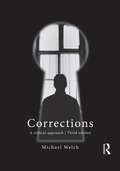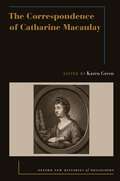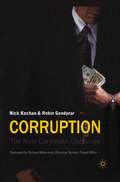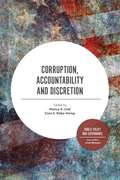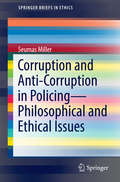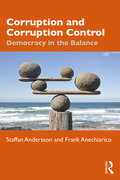- Table View
- List View
Correctional Counseling and Rehabilitation
by Emily J. Salisbury Patricia Van VoorhisThis text presents the foundations of correctional treatment and intervention, including overviews of the major therapeutic modalities that are effective when intervening with justice-involved individuals to reduce ongoing system involvement and improve well-being. The text also focuses on diagnosis of mental illness, correctional assessment and classification, case planning strategies, and the necessary counseling and human service skills for working alongside system-involved people. Specific chapters focus on working with women, individuals struggling with substance abuse, and clients with severely antisocial behavior such as psychopathy. Written to help students prepare for a career in correctional counseling or forensic social work, the book also assists working professionals (e.g., institutional and community corrections staff) to determine which strategies might be most effective with their clients. Revised using person-centered language, the tenth edition includes a new chapter focused on the necessary relational skills that probation and parole officers must have to be agents of behavior change. The content is divided into four parts: (1) A Professional Framework for Correctional Counseling; (2) Client Assessment, Diagnosis, Classification, and Case Planning; (3) Contemporary Approaches for Correctional Counseling and Treatment, and (4) Effective Correctional Interventions for Special Populations. This book is appropriate for upper-level undergraduates and graduate students in Criminal Justice and Criminology, Psychology, and Social Work programs, as well as correctional practitioners looking for professional development to enhance behavior change among clients.
Correctional Counseling and Rehabilitation
by Emily J. Salisbury Patricia Van VoorhisThis text presents the foundations of correctional treatment and intervention, including overviews of the major therapeutic modalities that are effective when intervening with justice-involved individuals to reduce ongoing system involvement and improve well-being. The text also focuses on diagnosis of mental illness, correctional assessment and classification, case planning strategies, and the necessary counseling and human service skills for working alongside system-involved people. Specific chapters focus on working with women, individuals struggling with substance abuse, and clients with severely antisocial behavior such as psychopathy. Written to help students prepare for a career in correctional counseling or forensic social work, the book also assists working professionals (e.g., institutional and community corrections staff) to determine which strategies might be most effective with their clients. Revised using person-centered language, the tenth edition includes a new chapter focused on the necessary relational skills that probation and parole officers must have to be agents of behavior change. The content is divided into four parts: (1) A Professional Framework for Correctional Counseling; (2) Client Assessment, Diagnosis, Classification, and Case Planning; (3) Contemporary Approaches for Correctional Counseling and Treatment, and (4) Effective Correctional Interventions for Special Populations. This book is appropriate for upper-level undergraduates and graduate students in Criminal Justice and Criminology, Psychology, and Social Work programs, as well as correctional practitioners looking for professional development to enhance behavior change among clients.
Corrections: A Critical Approach
by Michael WelchCorrections: A Critical Approach, 3rd edition confronts mass imprisonment in the United States, a nation boasting the highest incarceration rate in the world. This statistic is all the more troubling considering that its correctional population is overrepresented by the poor, African-Americans, and Latinos. Not only throwing crucial light on matters involving race and social class, this book also identifies and examines the key social forces shaping penal practice in the US - politics, economics, morality, and technology. By attending closely to historical and theoretical development, the narrative takes into account both instrumental (goal-oriented) and expressive (cultural) explanations to sharpen our understanding of punishment and the growing reliance on incarceration. Covering five main areas of inquiry - penal context, penal populations, penal violence, penal process, and penal state - this book is essential reading for both undergraduate and graduate students interested in undertaking a critical analysis of penology.
Corrections: A Critical Approach
by Michael WelchCorrections: A Critical Approach, 3rd edition confronts mass imprisonment in the United States, a nation boasting the highest incarceration rate in the world. This statistic is all the more troubling considering that its correctional population is overrepresented by the poor, African-Americans, and Latinos. Not only throwing crucial light on matters involving race and social class, this book also identifies and examines the key social forces shaping penal practice in the US - politics, economics, morality, and technology. By attending closely to historical and theoretical development, the narrative takes into account both instrumental (goal-oriented) and expressive (cultural) explanations to sharpen our understanding of punishment and the growing reliance on incarceration. Covering five main areas of inquiry - penal context, penal populations, penal violence, penal process, and penal state - this book is essential reading for both undergraduate and graduate students interested in undertaking a critical analysis of penology.
Corrections, Peacemaking and Restorative Justice: Transforming Individuals and Institutions
by Michael Braswell John Fuller Bo LozoffThis book views peacemaking as a broad, encompassing process that is expressed in many different shapes and forms. It blends ancient-wisdom traditions, peacemaking criminology, and restorative justice principles as a way of intervening with offenders in both institutional and community-based settings. Philosophical and spiritual contexts for peacemaking are presented that form a foundation for understanding the potential for peacemaking in criminological thought, the criminal justice system, and society in general.
Corrections, Peacemaking and Restorative Justice: Transforming Individuals and Institutions
by Michael Braswell John Fuller Bo LozoffThis book views peacemaking as a broad, encompassing process that is expressed in many different shapes and forms. It blends ancient-wisdom traditions, peacemaking criminology, and restorative justice principles as a way of intervening with offenders in both institutional and community-based settings. Philosophical and spiritual contexts for peacemaking are presented that form a foundation for understanding the potential for peacemaking in criminological thought, the criminal justice system, and society in general.
Corrective and Distributive Justice: From Aristotle to Modern Times
by Izhak EnglardCorrective and Distributive Justice: From Aristotle to Modern Times retraces the intricate history of the distinction between corrective and distributive justice. This distinction is elaborated in the 5th book of Aristotle's Nicomachean Ethics, which was rediscovered in Western Europe in the 12th and 13th centuries by the Scholastics and turned into a central topic in legal and theological scholarship. After a decline of interest in the wake of the enlightenment and secularization, a surprising revival of these notions of justice occurred in U.S. legal and philosophical discourse during the last four decades that has made this distinction a central issue in tort law, restitution and other important fields of private and public law. In literally hundreds of articles and a considerable number of books, the Aristotelian distinction has been elaborated, discussed, and applied. Englard's unique contribution to this aspect of legal history grants the contemporary reader a historical perspective that is vital for a deepened understanding of the distinction and modern concerns. Organized chronologically, Englard's research covers: Aristotle, High Scholastics, Late Scholastics, Post-Scholastics, and Modernity. The relevant literature is notoriously difficult to access, not only because of its Latin language, but because of the physical rarity of the relevant books scattered throughout the world. This book offers the modern reader a touchstone synthesis of intellectual and legal history.
Correlations in Rosenzweig and Levinas
by Robert GibbsRobert Gibbs radically revises standard interpretations of the two key figures of modern Jewish philosophy--Franz Rosenzweig, author of the monumental Star of Redemption, and Emmanuel Levinas, a major voice in contemporary intellectual life, who has inspired such thinkers as Derrida, Lyotard, Irigaray, and Blanchot. Rosenzweig and Levinas thought in relation to different philosophical schools and wrote in disparate styles. Their personal relations to Judaism and Christianity were markedly dissimilar. To Gibbs, however, the two thinkers possess basic affinities with each other. The book offers important insights into how philosophy is continually being altered by its encounter with other traditions.
Correlations in Rosenzweig and Levinas
by Robert GibbsRobert Gibbs radically revises standard interpretations of the two key figures of modern Jewish philosophy--Franz Rosenzweig, author of the monumental Star of Redemption, and Emmanuel Levinas, a major voice in contemporary intellectual life, who has inspired such thinkers as Derrida, Lyotard, Irigaray, and Blanchot. Rosenzweig and Levinas thought in relation to different philosophical schools and wrote in disparate styles. Their personal relations to Judaism and Christianity were markedly dissimilar. To Gibbs, however, the two thinkers possess basic affinities with each other. The book offers important insights into how philosophy is continually being altered by its encounter with other traditions.
Correlations in Rosenzweig and Levinas (PDF)
by Robert GibbsRobert Gibbs radically revises standard interpretations of the two key figures of modern Jewish philosophy--Franz Rosenzweig, author of the monumental Star of Redemption, and Emmanuel Levinas, a major voice in contemporary intellectual life, who has inspired such thinkers as Derrida, Lyotard, Irigaray, and Blanchot. Rosenzweig and Levinas thought in relation to different philosophical schools and wrote in disparate styles. Their personal relations to Judaism and Christianity were markedly dissimilar. To Gibbs, however, the two thinkers possess basic affinities with each other. The book offers important insights into how philosophy is continually being altered by its encounter with other traditions.
CORRESP OF CATHARINE MACAULAY ONHP C (Oxford New Histories of Philosophy)
by Karen GreenCatharine Macaulay was a celebrated republican historian, whose account of the reasons for the seventeenth-century English Revolution, the parliamentary period, and its aftermath was widely read by the mothers and fathers of American Independence and by central players in the French Revolution. As well as publishing her eight volume history, spanning the period from the accession of James I to the Glorious Revolution of 1688, she wrote political pamphlets, offered a sketch of a republican constitution for Corsica, advocated parliamentary reform, and published a response to Edmund Burke's Reflections on the Revolution in France. Her Letters on Education of 1790 made a decisive impact on the thought of Mary Wollstonecraft, and her Treatise on the Immutability of Moral Truth opposed the skeptical and utilitarian attitudes being developed by Hume and others. This volume brings together for the first time all the available letters between her and her wide-ranging correspondents, who include George Washington, John Adams, Abigail Adams, Mercy Otis Warren, James Otis, Benjamin Rush, David Hume, James Boswell, Thomas Hollis, John Wilkes, Horace Walpole, Mary Wollstonecraft, Jacques-Pierre Brissot de Warville, and many other luminaries of the eighteenth-century enlightenment. It includes an extended introduction to her life and works and offers a unique insight into the thinking of her friends and correspondents during the period between 1760 and 1790, the crucible for the development of modern representative democracies. The Correspondence of Catharine Macaulay will appeal to scholars of philosophy, political thought, women's studies, and eighteenth-century history, as well as those interested in the development of democratic ideas.
The Correspondence of Catharine Macaulay (Oxford New Histories of Philosophy)
Catharine Macaulay was a celebrated republican historian, whose account of the reasons for the seventeenth-century English Revolution, the parliamentary period, and its aftermath was widely read by the mothers and fathers of American Independence and by central players in the French Revolution. As well as publishing her eight volume history, spanning the period from the accession of James I to the Glorious Revolution of 1688, she wrote political pamphlets, offered a sketch of a republican constitution for Corsica, advocated parliamentary reform, and published a response to Edmund Burke's Reflections on the Revolution in France. Her Letters on Education of 1790 made a decisive impact on the thought of Mary Wollstonecraft, and her Treatise on the Immutability of Moral Truth opposed the skeptical and utilitarian attitudes being developed by Hume and others. This volume brings together for the first time all the available letters between her and her wide-ranging correspondents, who include George Washington, John Adams, Abigail Adams, Mercy Otis Warren, James Otis, Benjamin Rush, David Hume, James Boswell, Thomas Hollis, John Wilkes, Horace Walpole, Mary Wollstonecraft, Jacques-Pierre Brissot de Warville, and many other luminaries of the eighteenth-century enlightenment. It includes an extended introduction to her life and works and offers a unique insight into the thinking of her friends and correspondents during the period between 1760 and 1790, the crucible for the development of modern representative democracies. The Correspondence of Catharine Macaulay will appeal to scholars of philosophy, political thought, women's studies, and eighteenth-century history, as well as those interested in the development of democratic ideas.
The Correspondence Theory of Truth (Routledge Revivals)
by D. J. O'ConnorFirst published in 1975, The Correspondence Theory of Truth examines the simplest statements of empirical fact and establishes what we can mean when we say that such statements are true. In particular, the author has considered whether any or all of beliefs, sentences, statements, or propositions are properly said to be true or false. He proceeds to examine what we mean by the term ‘fact’ and what possible relation between facts and beliefs (or their linguistic embodiments) could be meant by the term ‘correspondence’. The second part of the book is a critical survey of important contemporary accounts of truth. The author examines Tarski’s semantic theory to see if it offers a satisfactory reconstruction of the essence of the traditional notion of correspondence, then J.L. Austin’s recent and famous version of the correspondence theory and some criticisms of it by Professor P. E. Strawson. A final chapter summarizes the viable content of the correspondence theory and suggests what problems about truth still remain for discussion if the theory is accepted. This book will be an essential read for students and scholars of Philosophy.
The Correspondence Theory of Truth (Routledge Revivals)
by D. J. O'ConnorFirst published in 1975, The Correspondence Theory of Truth examines the simplest statements of empirical fact and establishes what we can mean when we say that such statements are true. In particular, the author has considered whether any or all of beliefs, sentences, statements, or propositions are properly said to be true or false. He proceeds to examine what we mean by the term ‘fact’ and what possible relation between facts and beliefs (or their linguistic embodiments) could be meant by the term ‘correspondence’. The second part of the book is a critical survey of important contemporary accounts of truth. The author examines Tarski’s semantic theory to see if it offers a satisfactory reconstruction of the essence of the traditional notion of correspondence, then J.L. Austin’s recent and famous version of the correspondence theory and some criticisms of it by Professor P. E. Strawson. A final chapter summarizes the viable content of the correspondence theory and suggests what problems about truth still remain for discussion if the theory is accepted. This book will be an essential read for students and scholars of Philosophy.
Corridors of Power (Strangers and Brothers #9)
by C. P. SnowLewis Eliot walks the echoing corridors of Whitehall observing political intrigues and shifting alliances in this exceptional portrait of the heart of the British government during the Suez Crisis. At its centre is Roger Quaife, an ambitious MP determined to denuclearize Britain. His weapons: persuasiveness and a consummate skill in top-level diplomacy. In the committee rooms of Whitehall he plays with the highest stakes imaginable as he challenges the Government’s armaments policy. What ensues is a fascinating study of power – personal and political – handled with Snow’s inimitable authenticity and intimacy. Deservedly famed as one of the most accomplished political novels of all time, Corridors of Power goes behind the scenes of the Cold War with precision and humanity.A meticulous study of the public issues and private problems of post-war Britain, C. P. Snow’s Strangers and Brothers sequence is a towering achievement that stands alongside Anthony Powell’s A Dance to the Music of Time as one of the great romans-fleuves of the twentieth century.Praise for the Strangers and Brothers sequence“Together, the sequence presents a vivid portrait of British academic, political and public life. Snow was that rare thing, a scientist and novelist.” Jeffrey Archer, Guardian“Balzacian masterpieces of the age” Philip Hensher, Telegraph“Through [the Strangers and Brothers sequence] as in no other work in our time we have explored the inner life of the new classless class that is the 20th century Establishment” New York Times“A very considerable achievement … It brings into the novel themes and locales never seen before (except perhaps in Trollope).” Anthony Burgess“The most comprehensive, the most informative and, all in all, the most impressive portrait of modern England that any novelist has yet given us.” Michael Millgate, Commentary
Corrupted: A Rosato And Dinunzio Novel (Rosato & DiNunzio #3)
by Lisa ScottolineHot on the heels of ACCUSED and BETRAYED, CORRUPTED is the third legal thriller in New York Times bestseller Lisa Scottoline's electrifying Rosato & Di Nunzio series.For Bennie Rosato, founder of the Rosato & DiNunzio law firm, failure has never been an option. Thirteen years ago, she took on Jason Leftavick, a twelve-year-old boy who was sent to a juvenile detention center after fighting a class bully. Bennie couldn't free Jason, and his remains the one case that haunts her. Now out of prison, Jason's adulthood hasn't been much easier. And when he is indicted for killing the same bully he fought with as a child, Bennie sees no choice but to represent him. She doesn't know whether to believe his innocence, but she knows she knows this time she cannot let him down. Now, as she is forced to relive the darkest period of her life, Bennie will do everything in her power to get the truth, and justice...
Corruption: What Everyone Needs to Know® (What Everyone Needs To Know®)
by Ray Fisman Miriam A. GoldenCorruption regularly makes front page headlines: public officials embezzling government monies, selling public offices, and trading bribes for favors to private companies generate public indignation and calls for reform. In Corruption: What Everyone Needs to Know®, renowned scholars Ray Fisman and Miriam A. Golden provide a deeper understanding of why corruption is so damaging politically, socially, and economically. Among the key questions examined are: is corruption the result of perverse economic incentives? Does it stem from differences in culture and tolerance for illicit acts of government officials? Why don't voters throw corrupt politicians out of office? Vivid examples from a wide range of countries and situations shed light on the causes of corruption, and how it can be combated.
Corruption (Reflections)
by Mette Frisk JensenA short but engaging look at what makes Denmark one of the least corrupt countries in the world.Corruption is a profoundly destructive force around the world, but why does its extent vary so drastically among countries? In Corruption, Mette Frisk Jensen closely links the level of corruption in a country to its wealth, the happiness of its citizens, and the level of trust citizens have in their government. Covering the shifting concept of corruption from ancient Greece to modern-day cases, Frisk Jensen discusses why corruption has historically been low in Denmark in particular. She outlines how transparency, meritocratic recruitment, bureaucratic autonomy, high standards of accountability, and impartial legal institutions have been used to combat corruption and what lessons can be learned from these policies.ReflectionsIn Reflections, a series copublished with Denmark's Aarhus University Press, scholars deliver 60-page reflections on a key concept that encapsulates their years of study and research. These books present unique insights on a wide range of topics and concepts—everything from love, trust, and play, to corruption, welfare, and sleep—that entertain and enlighten readers with exciting discoveries and new perspectives.
Corruption (Reflections)
by Mette Frisk JensenA short but engaging look at what makes Denmark one of the least corrupt countries in the world.Corruption is a profoundly destructive force around the world, but why does its extent vary so drastically among countries? In Corruption, Mette Frisk Jensen closely links the level of corruption in a country to its wealth, the happiness of its citizens, and the level of trust citizens have in their government. Covering the shifting concept of corruption from ancient Greece to modern-day cases, Frisk Jensen discusses why corruption has historically been low in Denmark in particular. She outlines how transparency, meritocratic recruitment, bureaucratic autonomy, high standards of accountability, and impartial legal institutions have been used to combat corruption and what lessons can be learned from these policies.ReflectionsIn Reflections, a series copublished with Denmark's Aarhus University Press, scholars deliver 60-page reflections on a key concept that encapsulates their years of study and research. These books present unique insights on a wide range of topics and concepts—everything from love, trust, and play, to corruption, welfare, and sleep—that entertain and enlighten readers with exciting discoveries and new perspectives.
Corruption: The New Corporate Challenge
by N. Kochan R. GoodyearThe dangers of involvement in corruption need to be embedded in corporate strategy. Companies' response to these dangers must also be reflected in their practices, particularly if operating outside its own borders. This book guides managers through the complexity of bribery issues with advice on how to implement anti-corruption strategies.
Corruption, Accountability and Discretion (Public Policy and Governance)
by Professor Nancy S. Lind Cara E. Rabe-HempThe corruption of public officials in the United States and its corrosive impact on public policy, political stability and democratic institutions, earns it a spot among the most critical public crises of the last decade. There have been scandals involving elected officials across the political spectrum from local elected officials up to the White House, involving conflicts of interest, campaign fundraising and political elections. At the heart of many scandals is the discretionary power of public officials to make decisions based on personal interest, often leading to corruption. Understanding the nature and etiology of corruption is important to drafting controls on discretion and rules for accountability. While strict regulation and oversight mechanisms have previously been designed to encourage ethical decision-making and punish violators, it is the media and citizens that have increasingly become modern mechanisms of accountability. Corruption of public governance not only undermines the effectiveness of the political system; it also results in corrupt public policymaking on the most pressing issues facing Americans today. This timely and insightful book provides the key elements needed to understand the nature and prevalence of corruption in public governance, as well as the devastating public policy consequences. The chapters explore the implications of public governance corruption on political stability, public trust, and policymaking, as well as recommendations for how to establish controls on discretion and strict regulation to increase accountability and corruption control in public governance.
Corruption, Accountability and Discretion (Public Policy and Governance)
by Professor Nancy S. Lind Cara E. Rabe-HempThe corruption of public officials in the United States and its corrosive impact on public policy, political stability and democratic institutions, earns it a spot among the most critical public crises of the last decade. There have been scandals involving elected officials across the political spectrum from local elected officials up to the White House, involving conflicts of interest, campaign fundraising and political elections. At the heart of many scandals is the discretionary power of public officials to make decisions based on personal interest, often leading to corruption. Understanding the nature and etiology of corruption is important to drafting controls on discretion and rules for accountability. While strict regulation and oversight mechanisms have previously been designed to encourage ethical decision-making and punish violators, it is the media and citizens that have increasingly become modern mechanisms of accountability. Corruption of public governance not only undermines the effectiveness of the political system; it also results in corrupt public policymaking on the most pressing issues facing Americans today. This timely and insightful book provides the key elements needed to understand the nature and prevalence of corruption in public governance, as well as the devastating public policy consequences. The chapters explore the implications of public governance corruption on political stability, public trust, and policymaking, as well as recommendations for how to establish controls on discretion and strict regulation to increase accountability and corruption control in public governance.
Corruption and Anti-Corruption in Policing—Philosophical and Ethical Issues: Philosophical And Ethical Issues (SpringerBriefs in Ethics)
by Seumas MillerHigh levels of police corruption have been a persistent historical tendency in police services throughout the world. While the general area of concern in this book is with police corruption and anti-corruption, the focus is on certain key philosophical and ethical issues that arise for police organisations confronting corruption. On the normative account proffered in this book the principal institutional purpose of policing is the protection of legally enshrined moral rights and the principal institutional anti-corruption arrangement is what is referred to as an integrity system. The latter includes oversight bodies with investigative powers and internal affairs departments as well as specific devices such as early warning indicators, professional reporting mechanisms and integrity tests. Key concepts analysed in the book include corruption, noble cause corruption and collective moral responsibility. The key ethical issues analysed include investigative independence, professional reporting, covert operations and integrity tests.
Corruption and Constitutionalism in Africa (Stellenbosch Handbooks in African Constitutional Law)
by Charles M Fombad, Nico SteytlerThis collection of essays to focuses on the critical issue of corruption that lies at the heart of the crisis of constitutionalism in Africa. Most anti-corruption measures over the years have been inadequate, serving merely as symbolic gestures to give the impression something is being done. The African Union's declaration of 2018 as the 'African anti-corruption year', belated though it be, is an open recognition by African governments of the impact corruption will have on the continent unless urgent steps are taken. The key objective of this volume is to draw attention to the problem of corruption, the complexity of the situation, with all its multi-faceted social, political, economic and legal dimensions, and the need for remedial action.
Corruption and Corruption Control: Democracy in the Balance
by Staffan Andersson Frank AnechiaricoCorruption in politics and public administration is pervasive and difficult to eliminate. It has a strong effect on public attitudes toward government and is at the same time badly understood. A clear, comprehensive understanding of corruption is critical to the goal of ethical government that is trusted by the public. In this short and accessible text, Staffan Andersson and Frank Anechiarico demonstrate how the dynamics of life in organizations both generate corruption and make it difficult to prevent without undermining the effectiveness of government. They argue that how we define corruption, how we measure it, and how we try to combat it are strongly interrelated and should not be seen as separate issues. The authors demonstrate how this integrated approach, together with a focus on the damage caused by corruption to civic inclusivity and participation, can serve as an entry point for understanding the quality of democracy and the challenge of good governance. Using examples from mainly the United States and Sweden, Andersson and Anechiarico establish that recent anti-corruption reforms in public administration have often been narrowly focused on bribery (exchange corruption) and law enforcement approaches, while doing too little to other problems and forms of corruption, such as interest conflict. Corruption and Corruption Control: Democracy in the Balance will be of great interest to all students of politics, public administration and management, and ethics.

